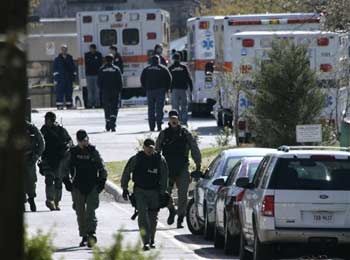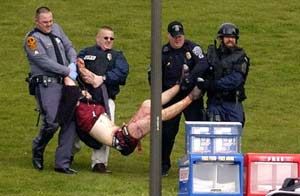Part 1 of a 2-part series
Read Part 2
Few in this country will ever forget the images from April 16, 2007, the day Virginia Tech University campus became the scene of a gruesome bloodbath. In a matter of minutes, sociopathic gunman Seung-Hui Cho shot 32 people before killing himself. It was the deadliest shooting in modern U.S. history.
In August of this year, airwaves were jammed with the findings of a new report on the Va. Tech incident that praised the police response as “prompt and effective,” but also noted that “university police may have erred in prematurely concluding that the first two shootings were the result of a domestic dispute” — a potential mistake, they say, that cost precious minutes.
While the above speaks specifically to the first of two distinct stages of the shooting that occurred on campus, it serves as a grim reminder of this fact: Active shooters are claiming more casualties in less time than ever before.
The Stopwatch of DeathThe murder statistics of the 44 active shooter incidents (**for which data are available) that have taken place in North America since 1966 are indeed chilling, made more so by the fact that so many of the victims have been children. As human beings, it seems an incomprehensible task to make sense of the carnage.
But can something be learned from the dispassionate numbers — a way to “crunch” them, to boil these incidents down to find a usable, tactical solution? According to Ron Borsch, manager and trainer at the SEALE Regional Training Academy in Bedford, Ohio, there is.
He calls it “The Stopwatch of Death.”
Borsch created a model called the Stopwatch of Death in order to provide a reliable unit of measurement with which to determine the scale of one active shooter incident relative to another:Number of murder attempts / Number of minutes = X
Borsch bases the number of murder attempts on the number of casualties (dead or wounded by a bullet) and divides that by the number of minutes within which the shooting takes place.
 Police leave the back area of Norris Hall, the site of the Virginia Tech shooting, April 16, 2007. (AP Photo/Steve Helber) |
The result is a single number (X), called the ‘Stopwatch of Death factor,’ that is assigned to each active shooter incident for which a known time exists.
For example, when Borsch applied his formula to the 1966 Texas Tower incident, which lasted 90 minutes, he came up with ½ of a murder attempt per minute; the 1984 San Ysidro, Calif. McDonald’s massacre, which lasted 70 minutes, had a Stopwatch of Death factor of, again, ½ murder attempt per minute.
“These incidents were mass murder,” he said, “but not mass murder quickly.”
The ominous trend
As he ran the numbers on each successive incident up through Virginia Tech, one thing became strikingly clear: The time frame in active shooter incidents is getting tighter.
“A Virginia Tech insider shared that 30 dead and 25 wounded were accomplished in 7 minutes,” said Borsch. “The Stopwatch of Death factor here is 7.9 (murder attempts per minute) — four times that of Columbine (2.1), and over twice that of Dawson College in Montreal (2.9).”
In other words, at Virginia Tech, the worst mass-murder by a solo active shooter to date, one shooter committed twice as many murders (32 casualties) in less than half the time it took the two Columbine shooters to kill 13.
 A wounded student is carried out of Norris Hall at Virginia Tech in Blacksburg, Va. on Monday, April 16, 2007. (AP Photo/The Roanoke Times, Alan Kim) |
“We’ve seen this trend go steadily up,” said Borsch. “The killers try for a bigger score card than their predecessors, which means that more cops need to be ready to go in and take care of business.”
With this trend confirmed, it’s clear that time is the key factor in the development of countermeasure strategies.
With so many lives hanging in the balance during these few minutes, there is an extreme urgency for patrol officers to know how to make entry and deal with these situations, rather than waiting and containing the scene in anticipation of SWAT’s arrival.
This has major implications when it comes to determining response models and formations, namely, training patrol-level officers to go in and defuse the threat on the spot. This is already happening in many areas. (Be sure to read Rick Armellino’s recent P1 article When they come to kill the kids: The critical need for “Immediate Action Rapid Deployment”.)
“If the death and destruction is done within [the post-Columbine mass murder average of] 8 minutes, every second counts,” Borsch said. “The buck stops with us for the final option of armed intervention when the active shooting takes place.”
The escalation both in the number of active shooter incidents and in the scale of their destruction are cause for concern. One explanation is the tendency of the gunmen to study other infamous examples in hopes of “beating” the last one’s number and gaining what they perceive as immortality in the pantheon of active shooters.
“These are sick people,” said Borsch. “They have a compulsion to be the ‘biggest’ and the ‘best.’
But these shooters are not infallible. They can — and have — been successfully countered.
The shortest response time saves lives
Borsch highlighted three examples as illustrative of what he calls the most effective response models to date. In each one, patrol-level officers went in, aborted the situation — and were not hurt:
| Red Lake, Minn. (2005) 7 dead, 7 wounded/9 minutes = 1.5 SWDA solo officer with a patrol rifle entered the school and shot the criminal twice; the shooter then limped into a room and shot himself. Dawson College, Montreal, Canada (2006) 1 dead, 19 wounded/7 minutes = 2.9 SWD Trolley Square, Salt Lake City, Utah (2007) 5 dead, 4 wounded/6 minutes = 1.5 SWD |
If we consider the responses, at right, to be successful based on the relatively few deaths that took place within a short timeframe, then it is reasonable to conclude that the shortest response time saves lives.
Lt. Col. Dave Grossman, a
“In a lone gunman scenario like Virginia Tech, a response by one officer could be sufficient to defeat the threat,” he said. “At a minimum, one officer can delay and disrupt the killer, as in the recent
Grossman noted that at both Virginia Tech and
In a situation with multiple shooters, the same rules apply.
“I teach that one man, or one woman, behind cover, bringing effective fire, can pin down an entire company for five minutes,” Grossman said. “Five minutes later there will be four of your friends there; in another five minutes there will be a dozen of your friends there; in another five minutes there will be twenty of your friends there. And it will be over.”
Thus, the action taken by the first, second or first few officers from an agency determines success — not that of a large mutual aid operation. (Mutual aid will eventually be needed for the rescue of casualties).
In October 2006, in a piece for Police1, Charles Remsberg gave a harrowing account of an active killer on the loose in a Denver warehouse — a 1.5 square mile labyrinthine structure choked with smoke and filling with ankle-deep water from the tripped sprinkler system. The concrete walls of the warehouse drastically reduced radio communication. One victim was dead, and an unknown number remained at risk. Worse yet, it was a Sunday. Denver SWAT’s day off (meaning it took longer than usual for technicians to arrive at the scene).
However, a bloodbath in the early 1990s had prompted the Denver PD to train its patrol officers for active shooter response. Their mission to “seek out where shots are being fired or are last known to have been fired and work toward that area as quickly as possible to neutralize the threat” was put into action.
Remsberg wrote:
At 3:24 p.m., a team of half a dozen District 2 officers led by Sgt. Steve Gonzales made entry on the north side of the warehouse near the area where Ford had fired his first volleys. They were accompanied by tactics-trained paramedic support. “They went in knowing they might be shot,” Cmdr. Conner told reporters.
Quickly, the group came upon Ford’s first four victims. All were still alive, although at least two were critically injured. “The two with head wounds almost certainly would have died if they’d laid there much longer,” says SWAT’s Frank Conner. “Those officers saved lives by making immediate entry.”
The evidence supporting a shift in the patrol-level response paradigm is straightforward. Getting there, however, might not be. In Part 2 of this article, you’ll hear from law enforcement experts on what it will take to effect a sea change — starting with the very definition of “active shooter.”
Ron Borsch is interested in any feedback that will help the overall rseponse efforts across the United States. Email Ron rbi0075@juno.com
** “Rapid Deployment as a resonse to an active shooter incident,” Illinois State Police Academy, 2003.
Electronic copies of the report are available by emailing Richard Fairburn at richard_fairburn@isp.state.il.us












